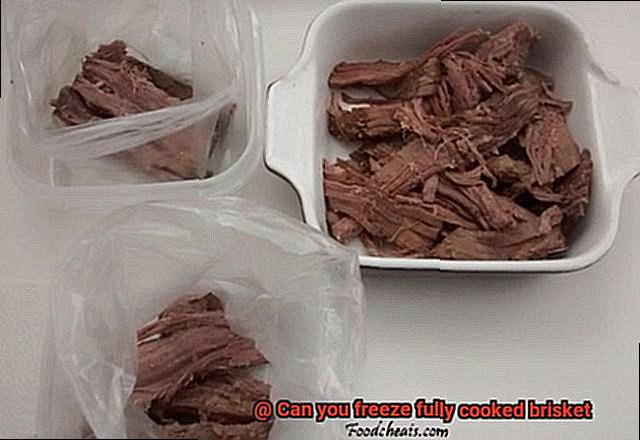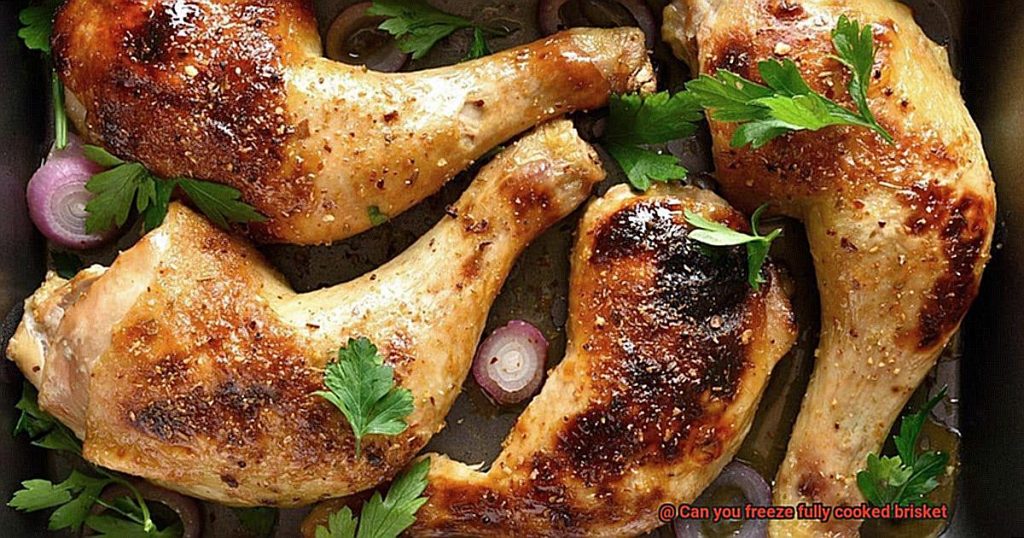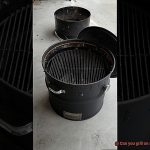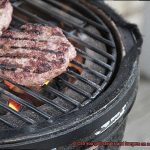Picture this: you’ve just devoured a mouthwatering, melt-in-your-mouth brisket. But now you’re left with a mountain of leftovers and a burning question – can you freeze fully cooked brisket? Well, fear not my hungry friends, because today we’re delving into the world of freezing fully cooked brisket. Whether you’re a culinary expert or just a passionate home cook, this blog post is here to satisfy your craving for knowledge. So grab a chair and get ready to uncover the secrets of preserving that brisket perfection in the icy depths of your freezer.
Contents
What is Fully Cooked Brisket?
Look no further than fully cooked brisket – a tender, flavorful cut of beef that will leave your taste buds begging for more. In this guide, we’ll explore the ins and outs of fully cooked brisket, from its mouthwatering preparation to proper storage techniques. So grab your apron and let’s get grilling.
What is fully cooked brisket?

Fully cooked brisket refers to a piece of beef brisket that has been slow-cooked until it is tender and ready to eat. Originating from the chest area of a cow, brisket is known for its rich flavor and juicy texture. To achieve melt-in-your-mouth goodness, the tough connective tissues are broken down through slow cooking.
The cooking process:
To prepare fully cooked brisket, start by seasoning the meat with a rub or marinade. Then, choose your preferred cooking method such as smoking, braising, or roasting. Slow-cook the brisket for several hours at a low temperature until it reaches an internal temperature of around 195-205°F (90-96°C). This ensures that the collagen in the meat breaks down, resulting in a tender and flavorful end product.
Serving suggestions:
Once fully cooked, brisket can be served immediately. You have the option to slice it or shred it, depending on your preference. Pair it with barbecue sauce and traditional sides like coleslaw, baked beans, or cornbread for a complete meal experience. The smoky and savory flavors of fully cooked brisket make it a popular choice for barbecues, picnics, and family gatherings.
Freezing and storing fully cooked brisket:
To freeze fully cooked brisket, first cool it quickly and refrigerate within two hours of cooking. When ready to freeze, use plastic wrap, aluminum foil, or airtight containers for packaging. Properly labeled, it can be stored in the freezer for an extended period.
Thawing and reheating frozen fully cooked brisket:
For safe thawing, transfer frozen brisket to the refrigerator overnight. When reheating, options include oven baking, stovetop heating, or microwave. Take care to maintain the quality and flavor of the brisket after freezing.
Food safety considerations:
When handling leftovers, remember to refrigerate within two hours of cooking. Signs of spoilage should be noted, and any questionable batches should be discarded.
Can You Freeze Fully Cooked Brisket?
I’m here to tell you that yes, you absolutely can. Freezing fully cooked brisket is not only possible but can also be a game-changer when it comes to preserving those mouthwatering leftovers or preparing in advance for your next barbecue feast.
Preparation for Freezing:
Now that we know freezing fully cooked brisket is on the menu, let’s dive into the process. Before you start packing those brisket slices for the icy adventure, there are a few key steps to ensure optimal texture and flavor preservation.
- Cool Completely: First and foremost, make sure your brisket has cooled completely. This helps maintain its moisture when thawed and prevents any unwanted bacterial growth.
- Portioning: It’s always a good idea to slice your fully cooked brisket into portions suitable for your needs before freezing. This way, you can easily thaw and use only what you need without having to defrost the entire brisket.
- Packaging: After slicing, wrap each portion tightly in plastic wrap or aluminum foil. This step ensures that no pesky freezer burn sneaks its way into your perfectly cooked meat. For an extra layer of protection, place the wrapped brisket portions in a resealable freezer bag or an airtight container. Squeeze out as much air as possible before sealing to prevent freezer burn from compromising the quality of your delicious brisket. Remember to label each package with the date of freezing for freshness tracking.
The Thawing Process and Reheating:
Now that your fully cooked brisket is safely nestled in the frosty depths of your freezer, let’s move on to the thawing process. When you’re ready to indulge in that smoky delight, simply transfer the frozen brisket from the freezer to the refrigerator and allow it to thaw overnight.
Once thawed, it’s time to bring that brisket back to life. You have multiple options for reheating – from oven baking to stovetop heating, or even throwing it back on the grill for a quick warm-up. Whichever method you choose, make sure to heat the brisket thoroughly until it reaches an internal temperature of at least 165°F (74°C) for food safety reasons.
How to Properly Store and Freeze Fully Cooked Brisket
Imagine indulging in the mouthwatering taste of brisket all year round. By properly storing and freezing fully cooked brisket, you can enjoy the smoky, flavorful meat whenever you desire. But why is it important to store and freeze brisket correctly? Let’s explore the reasons why and learn how to preserve brisket for optimal quality, texture, flavor, and safety.
Store It Right to Keep It Fresh:
After cooking your brisket to perfection, allow it to cool completely before storing it in the refrigerator. This crucial step prevents bacteria from multiplying and maintains its freshness. Wrap the brisket tightly in plastic wrap or aluminum foil, ensuring there are no air pockets. This ensures that air stays out while moisture remains trapped inside, preserving the meat’s succulence.
Freeze It for Future Feasts:
Freezing cooked brisket is a fantastic way to extend its shelf life and have delicious leftovers at your fingertips. Once the brisket has cooled down, divide it into smaller portions if desired. Wrap these portions tightly in heavy-duty aluminum foil or plastic wrap to prevent freezer burn. Place them in airtight containers or freezer bags, labeled with the date of freezing for easy tracking.
Timing Matters:
While frozen fully cooked brisket remains safe indefinitely, it is recommended to consume it within three to four months for optimal taste and texture. After this time, the quality might deteriorate slightly, but it will still be safe to eat.
Thawing: Slow and Steady Wins the Tender Meat Race:
When you’re ready to savor your frozen brisket, thaw it safely by transferring it from the freezer to the refrigerator overnight. This gradual thawing process helps retain moisture and keeps bacteria at bay. If you’re short on time, submerge the wrapped brisket in cold water, changing the water every 30 minutes until fully thawed.
Reheating: Low and Slow is the Way to Go.
To maintain the brisket’s tenderness and juiciness during reheating, use a low-temperature oven set to around 275°F or a slow cooker. Cover the brisket with foil to seal in the moisture and reheat for an hour or two until the internal temperature reaches 165°F. For an extra burst of flavor, add a splash of beef broth or barbecue sauce.
Labeling the Packaging for Freshness
Are you a grill enthusiast? Do you yearn for mouthwatering, melt-in-your-mouth brisket all year round? Well, listen up, because I’m about to reveal why labeling the packaging for freshness when freezing fully cooked brisket is absolutely crucial.
Imagine this: It’s a beautiful summer day, and you’ve fired up your trusty grill. The tantalizing aroma of smoky brisket fills the air as you sizzle those juicy slices to perfection. But what if I told you that you could have that same incredible flavor even in the dead of winter? That’s right, my friends – freezing fully cooked brisket is the answer.
Now, before you start tossing those delectable leftovers into the freezer, let’s talk about why labeling the packaging for freshness is so important. Trust me, it’s a game-changer.
- Keep track of freshness: By jotting down the freezing date on the packaging with a marker or labeling tape, you’ll always know if your brisket is still fresh and tasty or if it’s time to bid it farewell.
- Convenient details at your fingertips: Including a brief description of the brisket on the packaging will make your life even easier. Imagine having all the details – from the type of seasoning used to any additional ingredients or specific cooking instructions – right there in your freezer. It’s like having your own personal brisket cookbook.
- No more confusion: Let’s avoid those moments of freezer-induced confusion when reheating. By simply writing “Fully Cooked” on the packaging, you’ll never have to second-guess yourself again.
- Portion control made easy: Why not portion out that brisket before freezing? Divide it into smaller, individual servings, and label each portion separately. This way, you can defrost only what you need without the hassle of thawing the entire brisket.
But hold up – before you start labeling away, make sure you’re using the right packaging materials. Freezer-safe bags or airtight containers are your best friends when it comes to preserving the quality and taste of fully cooked brisket. Say goodbye to freezer burn and hello to deliciousness.
Storing Frozen Cooked Brisket
If so, it’s time to unlock the secret to storing and thawing frozen cooked brisket. This comprehensive guide will walk you through the process, ensuring that you can savor its melt-in-your-mouth flavor with ease.
Step 1: Properly Packaging for Freezing
- Wrap the brisket tightly in plastic wrap or aluminum foil to prevent freezer burn and preserve moisture.
- Consider using airtight containers or freezer bags for added protection against freezer burn.
Step 2: Divide and Label
- Divide the brisket into smaller portions before freezing to thaw only what you need at a time.
- Label your packaging with the date of freezing to keep track of storage time.
Step 3: Freezing
- Place the packaged brisket in the coldest part of the freezer for quick freezing and quality preservation.
- Frozen cooked brisket can last up to three months in the freezer without significant deterioration.
Step 4: Thawing
- Transfer the frozen cooked brisket from the freezer to the refrigerator and let it thaw slowly overnight for even thawing and minimal bacterial growth.
- Use the defrost function on your microwave or submerge the brisket in a sealed bag in cold water if time is limited, but be aware of potential moisture loss and texture changes.
Step 5: Reheating
- Reheat thawed cooked brisket gently using an oven, stovetop, or slow cooker.
- Avoid overcooking to prevent dryness and toughness.
- Check the internal temperature of the brisket, ensuring it reaches at least 165°F (74°C) to eliminate bacteria.
Reheating Frozen Cooked Brisket
So, you’ve got a stash of frozen cooked brisket, and you’re itching to relive the mouthwatering flavors of barbecue season. Fear not, grill enthusiasts. In this comprehensive guide, we’ll walk you through the best methods for safely reheating your frozen cooked brisket, so you can enjoy that tender, smoky goodness all over again. Get your tongs ready as we dive into the world of reheating brisket to perfection.
Thawing Your Brisket:
Before we fire up the grill, let’s start by thawing our frozen brisket properly. The key here is to take it slow and steady. Transfer your frozen brisket from the freezer to the refrigerator and let it thaw overnight. This gradual thawing process ensures even defrosting, preserving the taste and texture of the meat while minimizing any risk of bacterial growth.
Methods for Reheating Brisket:
Now that our brisket is defrosted and ready to sizzle, let’s explore different reheating methods to suit your grilling preferences:
Oven Reheating:
Preheat your oven to a low temperature (around 250°F). Place the thawed brisket in a baking dish with some liquid like beef broth or barbecue sauce to prevent dryness. Cover the dish with foil and bake for approximately 30 minutes or until the internal temperature reaches 165°F – ensuring a juicy, succulent result.
Stovetop Reheating:
For a quicker option that still delivers delicious results, slice or shred the thawed brisket into smaller pieces. Heat a skillet or pan over medium-low heat and add a bit of liquid such as broth or sauce to keep the meat moist. Gently reheat the brisket, stirring occasionally until it reaches your desired temperature.
Microwave Reheating:
When you’re short on time but still crave that smoky goodness, the microwave comes to the rescue. Place the thawed brisket in a microwave-safe dish with some liquid, loosely cover it, and heat on medium power in short intervals. Stir or flip the meat occasionally until it reaches the desired temperature, ensuring it doesn’t dry out.
Sous Vide Reheating:
For the adventurous grill masters equipped with a sous vide machine, this method guarantees tender and evenly reheated brisket. Vacuum-seal the thawed brisket in a bag and immerse it in a water bath at a controlled temperature for an extended period. This technique ensures maximum moisture retention and consistent heating throughout the meat.
Safety First:
Regardless of your chosen reheating method, always monitor the internal temperature of your brisket using a meat thermometer. Aim for at least 165°F to ensure food safety and prevent any potential foodborne illnesses.
Serving Suggestions:
Once your brisket is reheated to perfection, let your culinary creativity shine. Serve it as is or use it as the star ingredient in mouthwatering sandwiches, tacos, salads, or even as a topping for loaded baked potatoes. The possibilities are endless.
Effects of Freezing on Fully Cooked Brisket
We’ve all been there – you cook up a mouthwatering brisket, and before you know it, you have leftovers. So what do you do? Freeze it, of course. Freezing fully cooked brisket is a convenient way to preserve those barbecue flavors for a future feast. But what are the effects of freezing on the texture, flavor, and overall quality of your brisket? Let’s dig in and find out.
Texture Changes:
When you freeze fully cooked brisket, ice crystals form within the meat. As a result, some moisture may be lost during thawing, leading to a slightly drier texture compared to freshly cooked brisket. However, the extent of these texture changes can vary depending on the initial cooking method and the thawing process. So don’t worry too much – your brisket can still turn out tender and juicy.
Flavor Alterations:
Freezing can also affect the flavor of your fully cooked brisket. Some volatile compounds responsible for that smoky aroma and delicious taste may be lost during freezing. Additionally, if your brisket isn’t properly sealed or protected from freezer burn, it can develop off-flavors or odors due to exposure to air. So make sure you package it right to avoid any unwanted surprises when you defrost it.
Quality Preservation:
Despite potential texture and flavor changes, freezing fully cooked brisket still helps preserve its overall quality. By freezing it, you extend its shelf life and prevent spoilage. This means you can enjoy that delectable brisket at a later date without worrying about it going bad. Just remember to freeze it as soon as possible after cooking for the best results.
Packaging Considerations:
Proper packaging is key when freezing fully cooked brisket. Use airtight containers or freezer bags designed for long-term storage. Remove as much air as possible from the packaging to minimize the risk of freezer burn. You can even divide the brisket into smaller portions before freezing, making it easier to thaw and reducing waste.
Thawing Methods:
How you thaw your frozen fully cooked brisket can also impact its quality. The best method is to thaw it slowly in the refrigerator. This ensures a more even thaw and helps retain moisture. Avoid thawing at room temperature, as it can lead to bacterial growth and compromise food safety. If you’re in a hurry, you can use the defrost setting on your microwave or submerge it in cold water while sealed in a bag.
Reheating:
Once your fully cooked brisket is thawed, reheating it properly is crucial for food safety. Use a method that reheats the brisket thoroughly without overcooking or drying it out further. Options include using an oven, stovetop, or grill – go with what works best for you and your equipment.
Summary:
So there you have it – freezing fully cooked brisket may cause some changes in texture and flavor, but it’s still a great way to preserve those grilling triumphs. Just remember to package it carefully, thaw it properly, and reheat it with love. With these tips, you’ll be enjoying that tender, flavorful brisket all over again in no time.
Quality of the Fully Cooked Brisket After Freezing and Reheating
Well, I’ve got fantastic news for you. Freezing fully cooked brisket is not only possible but can still deliver a mouthwatering experience when reheated properly. But don’t worry, I’m here to guide you through the tricks of the trade to ensure that your brisket retains its quality and tastes just as heavenly as the day it was cooked.
To begin, allow your brisket to cool completely before even considering freezing it. This crucial step prevents any pesky bacteria from ruining your meaty masterpiece. So, let it chill in the fridge for a few hours or overnight until it’s perfectly cold.
Timing is everything. For optimum quality, freeze your fully cooked brisket within two hours of cooking. Don’t let it linger on the counter and risk encountering unappetizing surprises.
Now let’s talk packaging. To combat freezer burn and preserve those tantalizing flavors and juices, opt for airtight containers or heavy-duty freezer bags. Before sealing them up tight, make sure to suck out as much air as possible. And remember to label your package with the freezing date so you can keep track of its freshness.
When it’s time to reheat your frozen brisket, thaw it properly. The safest method is to defrost it in the refrigerator overnight. However, if you’re pressed for time, you can use the microwave or cold water thawing methods.
Now comes the exciting part – reheating. To maintain that tender, juicy goodness, set your oven to a low temperature, around 250°F (120°C). Seal the brisket with foil to lock in all those incredible flavors and moisture. A splash of liquid, like broth or barbecue sauce, can also prevent dryness and elevate the taste.
Safety first. Reheat your fully cooked brisket until it reaches an internal temperature of 165°F (74°C). This ensures both food safety and that every bite is bursting with flavor.
E5fLZDkDqlc” >
Conclusion
Yes, you can absolutely freeze fully cooked brisket.
It’s a great option for preserving the deliciousness of this mouthwatering meat. Whether you have leftovers or want to prepare ahead of time, freezing brisket is a convenient way to ensure you always have a tasty meal on hand.
Just imagine the convenience of pulling out that perfectly cooked brisket from your freezer whenever you’re craving it. So go ahead and wrap it up tightly in plastic wrap or aluminum foil, pop it in a freezer bag, and let the magic happen.
When you’re ready to enjoy your frozen masterpiece, simply thaw it in the refrigerator overnight and then reheat it gently on low heat.






